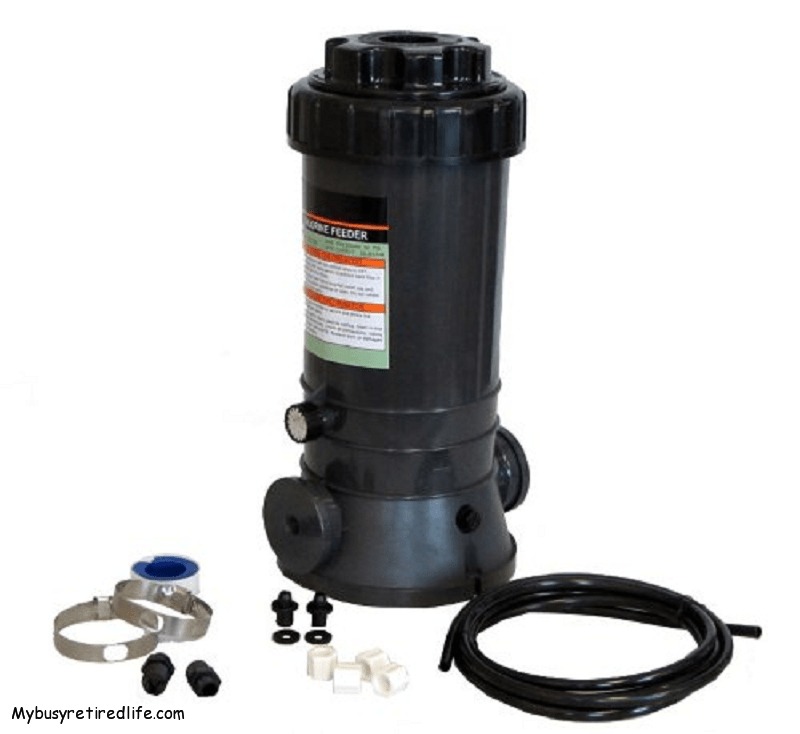My pool chlorinator
My pool chlorinator is probably the most important piece of equipment I own. I really like it because it makes taking care of my pool so much easier. I have used a chlorinator for quite a long time(well over ten years). I’m on my second chlorinator.
What I really like is that it relieves me of the chore of adding chlorine to the pool daily. All I have to do is set a day of the week when I will recharge my chlorinator. I use three-inch tabs in the chlorinator. When I am using it, my use of acid also goes down as there is some acid in the tablets.
Inline or Offline
I prefer an offline chlorinator over the hard-piped(inline) versions. When I first got one I had to make a choice between the two versions. It just made sense to me to not have it hard piped into my system. I figured that sooner or later something will go wrong with the unit and it will need replacement. With an inline(hard piped) unit what are you going to do then? There could be dimensional differences from one brand to another. An offline unit lets me replace the unit cleanly. The only thing that will be a concern is that the chlorine will eat away at the plastic parts downstream of the chlorinator. More on this issue later.
Installation of Offline Chlorinator
The unit is installed with small lines that connect the chlorinator to the hard piping. The first line is connected after the pump for the infeed line. Another line(the discharge from the chlorinator) connects to the return water line after the filter. It’s the difference in pressure between the filter that makes the system work. Flow is clearly marked on the canister so installation is easy. As far as installation goes the hardest part will be where to pick your connection points. A tip on their location. The infeed line has to be placed between the pump and the filter. For the return line make sure that it is located after any pool equipment. Chlorine is pretty corrosive.
Chlorine is corrosive
Chlorine is corrosive and will eat anything it touches. The return line fittings will definitely need replacing from time to time. I learned this the hard way once. A fitting broke and I didn’t have a spare so I went to the local hardware store and bought a brass fitting to replace that plastic one. I figured that I was way ahead of the game brass over plastic. Boy, was I wrong. That brass fitting didn’t last two months before the chlorine ate through the brass fitting. Since then I make sure that I buy a spare “parts kit” for my chlorinator to keep it on hand for such emergencies.
Filling the unit and setting the rate
When you open this thing up make sure that you are not directly over the chlorinator when you open it. There is definitely a puff of chlorine gas when you open it up. Did you know that chlorine gas was used during World War One as a weapon? I stand to the side and pull off the lid and leave to get my chlorine tabs. When I return the gas will have dissipated enough that you can fill it easily without discomfort.
Opening the canister requires a tool. If your handy you can make one that will fit over the lid’s outline. If you’re like me and need your time for other projects get yourself a strap wrench and it will work well enough. Besides, you can use it for other jobs later on. Anyway, you look at it, you will need a handle on the tool to leverage the lid free. The chlorinator’s base must be held to prevent movement when removing or replacing the chlorinator’s lid. I have mine screwed down to a 2X8 board long enough for me to put my foot on to prevent turning while I remove the lid.
Flow Problems
Problems with the unit not working are always about flow. I have had the small orifice plug up several times. I remove the infeed line and use my air compressor to blow the lines clear. How do I know it’s a flow problem? Well, the chlorine tablets always give it away. If the tablets start to dissolve more slowly than normal it’s time to check the orifice and lines.
If there’s one thing that could greatly change this chlorinator it would be a screen or filter on the inlet side of the canister. I haven’t found one yet but I’m sure that there is one out there that would work.
As far as the adjustment for flow goes I set it once and never touch it again. I have a 31K gallon pool so I use one large tablet for every 5000 gallons. So every week I add 6 tablets. Less in cool weather. I also don’t use the chlorinator from Oct to May. I switch over to powder during those months to keep my CYA levels low. The related post link below explains the strategy.
Related Post: Winter Months and CYA Levels
Related Post: Clear Sparkling Pool Water Strategy
Additional Post: Troubleshooting the offline automatic chlorinator
Additional Post: Offline Chlorinator Fitting Fails
When you fill the canister it is not one of those times when you throw in the tabs and close the lid. Watching the chlorinator fill with water confirms that there are no obstructions to water flow. You want to put your tabs in the canister and start the pump to fill the canister then put the lid on and tighten just enough to prevent water leaks. A canister full of water will prevent an air bubble from diminishing the effectiveness of the chlorinator. With your spare parts and expert installation, you will have years of service from a Chlorinator.





